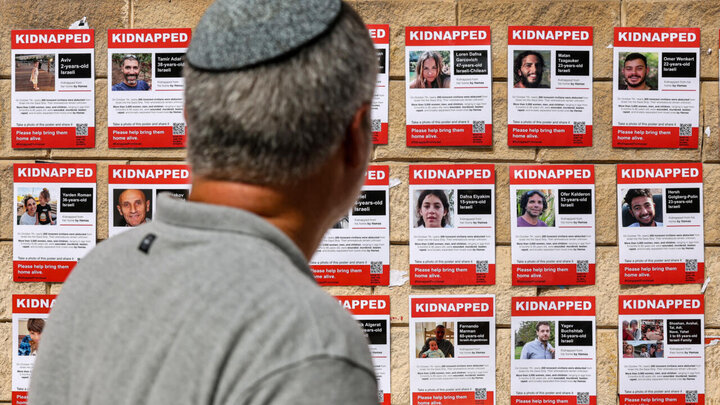The full text of Tel Aviv’s draft for a cease-fire in Gaza and a prisoner exchange

| The Zionist regime has presented its draft for the ceasefire and exchange of prisoners in such a way that although some setbacks can be seen in it, this plan still has many ambiguous and unacceptable points. |
report Mehr News, the Lebanese newspaper Al-Akhbar in its today’s issue, the full text of the draft presented by the Zionist regime regarding the ceasefire in Gaza and published the prisoner exchange operation that was delivered on Friday, April 26.
The full text of this draft is as follows:
The main principles of the agreement between the Israeli side and the Palestinian side in Gaza for the exchange of prisoners and detainees between the two sides And the return of lasting peace.
This agreement aims to release all Israeli prisoners in the Gaza Strip, including soldiers and civilians, living and dead people. It has been compiled and compliance with all clauses and schedules and stable peace is required to reach a ceasefire.
This agreement includes three steps as follows:
First stage: (40 days and renewable)
temporary suspension of mutual military operations between the two sides and the withdrawal of Israeli forces from the east of Gaza and away from the areas Full of people to the areas near the borders in all parts of Gaza (except the Gaza plain)
Stopping flights (including military and intelligence) for 8 hours a day and for 10 hours on days The beginning of the exchange of prisoners.
Return of civilian displaced persons to their residential areas
On the seventh day of this stage (after the release of all the captive women), the Israeli forces moved from Al-Rashid Street towards They retreat to the east and in the vicinity of Salahuddin Street to facilitate the arrival of humanitarian aid and to enable the return of civilian and unarmed refugees to their residential areas.
On the twenty-second day of this stage (after the release of two-thirds of the Israeli prisoners), the Israeli forces from the center of Gaza (especially al-Shahda Netsarim axis and al-Kuit square axis) are retreating to the east of Salah al-Din road and the areas close to the borders, so that the return of civilian refugees to their residential areas in the north of Gaza is possible.
Facilitating the entry of large and appropriate amounts of humanitarian aid, supplies and fuel (including 500 trucks provided that 50 the fuel truck and 250 trucks go to the north of Gaza). This fuel has been imported for electricity and trade facilities and equipment necessary for removing debris and restarting hospitals, medical centers and bakeries in all areas of Gaza, and this process will continue in all phases of the agreement.
Exchange of prisoners and detainees between the two sides
Hamas captured at least 33 prisoners, including all living Israeli female prisoners (including soldiers and settlers) and children (under 19 years old) and the elderly (over 50 years old) and the sick and injured, and Israel will release 20 Palestinian women and children for each Israeli captive woman and child, based on the lists that Hamas has arrested in order of priority. provided, will release.
Israel in exchange for the release of every female prisoner over 50 and the sick and wounded, 20 elderly prisoners (over 50 year and sick and injured) based on the lists provided by Hamas with priority of the date of detention. (provided that their sentence does not exceed 10 years).
Israel releases 40 Palestinian prisoners (20 of whom are serving life sentences) for every one captured. And 20 of them are among the people who have sentences of less than 10 years of imprisonment. Of course, in this case, Israel reserves the right to reject some names (up to 200 names).
Each of the prisoners who have life imprisonment and should be released according to this agreement, the possibility of their release in Available inside or outside Gaza.
Table of exchange of prisoners and detainees between the parties In the first step:
Hamas releases three Israeli prisoners on the first day and every three days, three prisoners are released This process continues for 33 days. On the other hand, Israel also releases the agreed number of Palestinian prisoners from prison based on the agreed list.
Hamas finally, by the end of the seventh day, the list of all the remaining detainees in its possession, plus these 33 people who are going to be released from different strata, and these people will be released from the 34th day onwards, and the extension of the suspension of military operations depends on the number of detained people, and for each additional prisoner who is released, one day of non-permanent truce is added, and the Israeli side also releases the agreed number of Palestinian prisoners from their prisons based on the agreed lists.
Continuation of the exchange operation to the extent of commitment to the clauses of the agreement, including the cessation of hostile operations and the redeployment of forces and the return of displaced persons. And it depends on the arrival of humanitarian aid.
Palestinian prisoners released on the charges for which they were previously detained will not be re-arrested. . The bases considered in the first stage will not be used as the basis for the second stage. In less than 16 days from the beginning of the first stage, (and after the release of half of the prisoners) indirect negotiations between the two sides will begin to reach a lasting ceasefire and review its provisions and preparations, and the United Nations and related agencies of other international organizations They also continue to provide humanitarian services in all areas of Gaza and this issue will continue in all phases of the agreement.
The reconstruction of Gaza’s infrastructure (including electricity, water, sewage, communication and transportation routes) will begin in all areas. and the necessary equipment for civil defense will enter the area in a coordinated manner to carry out the debris removal. This issue will continue in all phases.
Facilitating the entry of supplies needed to create a refugee camp to shelter people who lost their homes during the war. have lost, it will continue.
From the 14th day of the agreement, the agreed number of wounded soldiers will be allowed to pass through the Rafah crossing for their treatment. will be given.
Second stage (42 days)
At this stage of the agreement, the necessary preparations for a permanent ceasefire have been made and the Israeli forces have left Gaza. They retreat.
At this stage, the necessary measures for the comprehensive reconstruction of Gaza and the reconstruction of civilian homes and facilities and civilian infrastructures that result The destruction war will begin.
Third stage (42 days)
Exchanging all the dead bodies between the two sides after they are identified.
At this stage, the reconstruction plan of Gaza will begin for 5 years, which includes residential houses and civilian facilities and It is infrastructure. The Palestinian side will be prohibited from rebuilding military infrastructure and facilities, and will not be allowed to enter Gaza any of the equipment, raw materials, and tools used for military purposes.
The guarantors of the agreement: Qatar, Egypt and America


